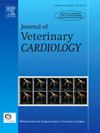法国斗牛犬的心脏基底肿瘤:一个病例系列
IF 1.3
2区 农林科学
Q2 VETERINARY SCIENCES
引用次数: 0
摘要
心基肿瘤(hbt)包括化学肿瘤在犬中很常见,特别是在短头犬中。这些肿瘤通常是偶然发现的,但也可导致血管阻塞、肿瘤侵袭、心包积液或转移等临床症状。本回顾性研究描述了32只法国斗牛犬HBTs的临床和影像学表现。动物、材料和方法对诊断为HBTs的法国斗牛犬(2019年4月至2022年10月)的医疗记录进行了回顾。病例分为两组:偶发HBTs犬(1组)和伴有HBTs临床症状的犬(2组)。收集的数据集中于临床特征和可用的诊断成像。结果1组14只犬偶然诊断为HBT;第2组(18只)的临床症状为呼吸困难、晕厥、腹水,其中13只伴有明显的浆液腔积液。2组超声心动图经常发现肿瘤阻塞肺干或其主要分支。一些肿瘤侵入心房。在测量这些变量时,2组狗的中位心率(138 vs 156/min)、右心房直径(22.0 vs 31.5 mm)和右心室至右心房收缩压梯度(48 vs 83 mm hg)更高(所有P<;0.05)。研究局限性:回顾性的性质和缺乏组织病理学来确认肿瘤类型和尸检结果是本研究的主要局限性。结论法国斗牛犬的心脏基底肿瘤在临床表现、严重程度和影像学特征上各不相同。这些肿瘤常引起血管阻塞、组织侵犯和腔内积液。本文章由计算机程序翻译,如有差异,请以英文原文为准。
Heart base tumors in French Bulldogs: a case series
Introduction/Objectives
Heart base tumors (HBTs) including chemodectomas are common in dogs, especially in brachycephalic breeds. These tumors are often incidental findings but can also lead to clinical signs from vascular obstruction, tumor invasion, pericardial effusion, or metastasis. This retrospective study describes clinical and imaging findings of HBTs in 32 French Bulldogs.
Animals, Materials and Methods
A review of medical records focused on French Bulldogs diagnosed with HBTs (April 2019 to October 2022) was conducted. Cases were divided into two groups: dogs with incidental HBTs (group 1) and dogs with clinical signs associated with HBTs (group 2). Collected data focused on clinical features and available diagnostic imaging.
Results
In group 1 dogs (n = 14), HBT was diagnosed incidentally; meanwhile, clinical signs in group 2 dogs (n = 18) included respiratory difficulties, syncope, and ascites with various combinations of serous cavity effusions evident in 13 dogs. Echocardiography of group 2 dogs frequently identified tumors obstructing the pulmonary trunk or its main branches. Some tumors invaded the atria. Median heart rate (138 vs. 156/mins), right atrial diameter (22.0 vs. 31.5 mm), and right ventricular-to-right atrial systolic pressure gradient (48 vs. 83 mm hg) were higher in the subset of group 2 dogs where these variables were measured (all P<0.05).
Study Limitations
The retrospective nature and absence of histopathology to confirm tumor type and autopsy findings are major limitations of the study.
Conclusions
Heart base tumors in French Bulldogs can vary in clinical presentation, severity, and imaging features. These tumors often cause vascular obstruction, tissue invasion, and cavitary effusions.
求助全文
通过发布文献求助,成功后即可免费获取论文全文。
去求助
来源期刊

Journal of Veterinary Cardiology
VETERINARY SCIENCES-
CiteScore
2.50
自引率
25.00%
发文量
66
审稿时长
154 days
期刊介绍:
The mission of the Journal of Veterinary Cardiology is to publish peer-reviewed reports of the highest quality that promote greater understanding of cardiovascular disease, and enhance the health and well being of animals and humans. The Journal of Veterinary Cardiology publishes original contributions involving research and clinical practice that include prospective and retrospective studies, clinical trials, epidemiology, observational studies, and advances in applied and basic research.
The Journal invites submission of original manuscripts. Specific content areas of interest include heart failure, arrhythmias, congenital heart disease, cardiovascular medicine, surgery, hypertension, health outcomes research, diagnostic imaging, interventional techniques, genetics, molecular cardiology, and cardiovascular pathology, pharmacology, and toxicology.
 求助内容:
求助内容: 应助结果提醒方式:
应助结果提醒方式:


